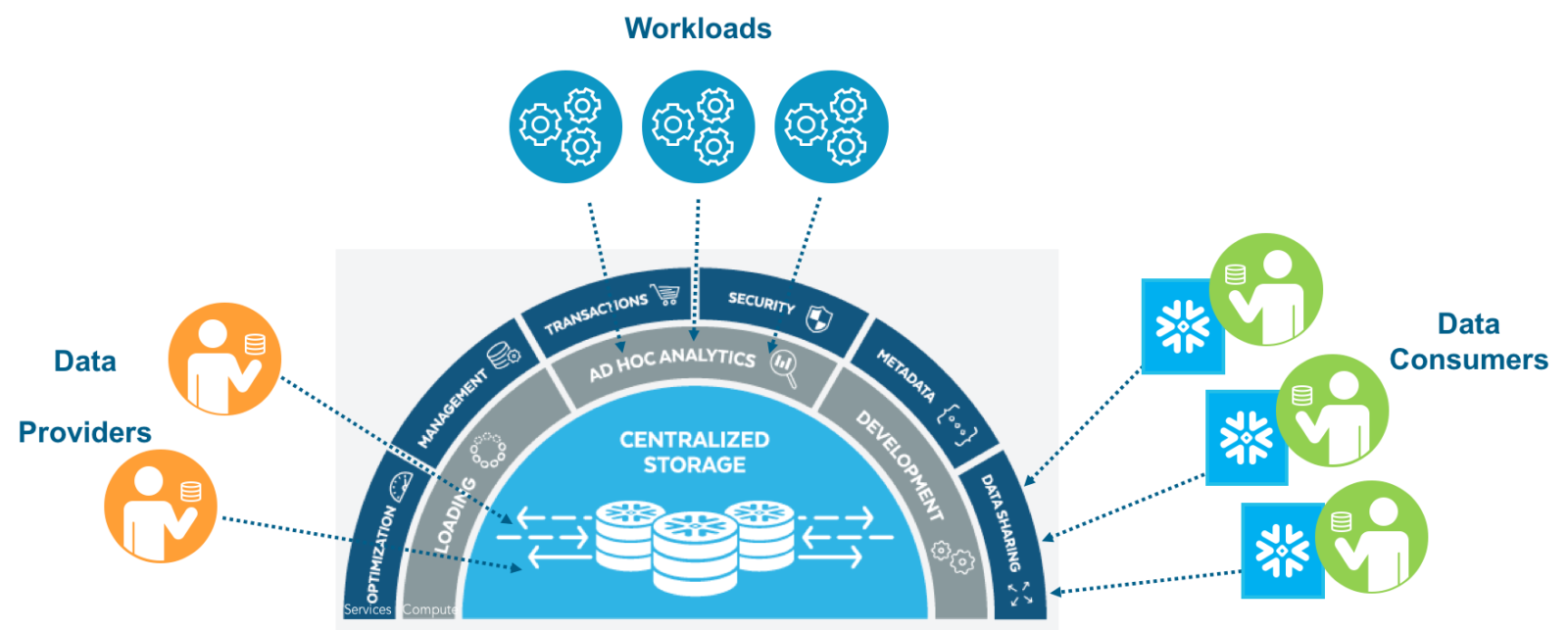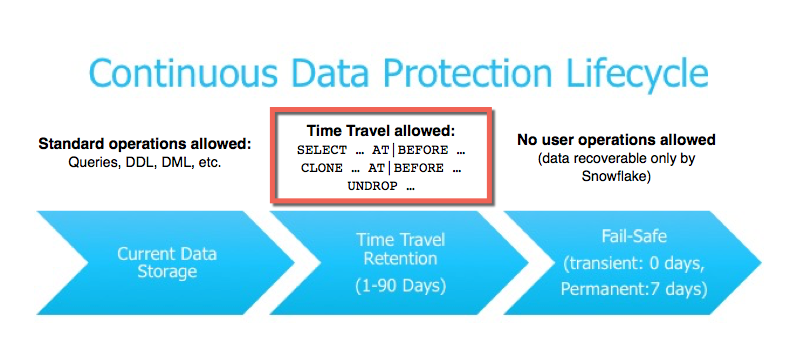Transient Tables can be created in Snowflake and are available to all users with the necessary credentials until they are expressly abandoned. Snowflake Transient Tables are comparable to Permanent Tables, except that they don’t have a fail-safe period. As a result, Transient Tables are meant for temporary data that must be kept after each session but do not require the same level of data protection and recovery as Permanent Tables.
Transient tables, like permanent tables, contribute to your account’s overall storage expenses; however, because Transient Tables do not use Fail-safe, there are no Fail-safe costs (i.e. the costs associated with maintaining the data required for Fail-safe disaster recovery).
The Snowflake Transient Table will be discussed in detail in this post. Continue reading to learn more!
Migrate your data into Snowflake seamlessly with Hevo. Our platform offers both pre and post-load transformations, ensuring your data is ready for analysis.
- Easy Integration: Connect and migrate data into Snowflake in minutes without any coding.
- Flexible Transformations: Use simple drag-and-drop transformations or custom Python scripts.
- Pre and Post-Load Transformations: Transform your data at any stage of the migration process.
Join over 2000 satisfied customers, including companies like Cure.Fit and Pelago, who trust Hevo for their data management needs.
Get Started with Hevo for FreeTable of Contents
What is Snowflake?
Snowflake is a Fully-managed Warehousing Service that enables clients to connect, load, analyze, and securely share their data while allowing for near-infinite concurrent operations scalability. Some of the most common use cases include Data Lakes, Data Engineering, Data Application Development, Data Science, and safe Data Consumption.
The architecture of Snowflake is unique in that it naturally separates computation and storage. This approach enables you to provide virtual access to a single copy of your data to your Users and Data Workloads without losing speed. Snowflake lets you execute your data solution across several locations and Clouds for a consistent experience.
Snowflake’s Virtual Warehouse concept applies to Amazon EC2 Clusters that provide query processing power. For quick Data Analysis, each virtual Warehouse contains an MPP EC2 Compute Cluster with many nodes. Snowflake maintains the on-demand scaling up and down of these Virtual Warehouses, as well as the ability to pause them while they’re not in use.
The Snowflake Data Marketplace, which allows you to connect with thousands of other Snowflake users, also provides access to shared datasets and data services. Visit the official Snowflake website for further additional information.
Key Features of Snowflake

Some of the advantages of employing Snowflake as a Software as a Service (SaaS) solution are as follows:
- Snowflake allows you to improve the quality and speed of your Analytics by switching from nightly Batch Loads to Real-time Data Streams in your Analytics Pipeline. You may increase the quality of Analytics at your firm by allowing secure, concurrent, and monitoring access to your Data Warehouse across your organization.
- The Caching Paradigm is used by Snowflake to deliver cache results quickly. Snowflake uses Persistent (during the session) Query results to prevent regenerating the report when nothing has changed.
- Snowflake enables you to break down silos and ensure that everyone in your organization has access to relevant data, leading to better data-driven decision-making. This is a critical first step toward improving partner relationships, optimizing pricing, lowering operational costs, and increasing sales effectiveness, among other things.
- You can use Snowflake to better understand customer behaviour and product usage. You can also use the entire scope of data to assure customer pleasure, improve product offerings dramatically, and drive Data Science Innovation.
- Snowflake lets you construct your own Data Exchange, allowing you to securely share live, regulated data. It also motivates you to strengthen data linkages throughout your business units, as well as with your partners and customers.
What is the Snowflake Transient Table?
Snowflake Transitory Tables are available to all users with the necessary credentials until they are expressly abandoned. The Transient Tables are for temporary data that needs to be kept after the current session has ended.

Transient tables are a useful alternative for managing the expense of very big tables used to hold transitory data because they don’t have a fail-safe period. However, after the Time Travel Retention Period expires, neither you nor Snowflake will be able to recover the data.
The Syntax for Snowflake Transient Table
Simply use the TRANSIENT term in your CREATE TABLE DDL command to create a Temporary Table.
create transient table trantablename (col1 type1, col2 type2, ... coln typen,);As an example,
create TRANSIENT table TEST3 (col1 int, col2 int);
+-----------------------------------+
| status |
|-----------------------------------|
| Table TEST3 successfully created. |
+-----------------------------------+How to Create a Snowflake Transient Table as a Permanent Table?
Snowflake Transient Tables, like other table types, are part of a specific Database and Schema. They are, nevertheless, governed by the same unique name restrictions because they are not session-based. This means you can’t use the same name for Transitory and Permanent tables.
Simply specify the “transient” keyword when constructing the object to create a transient table:
For Example,
--Permanent Table
select * from test;
+------+------+
| COL1 | COL2 |
|------+------|
| 1 | 1 |
| 2 | 2 |
| 3 | 3 |
+------+------+
-- Transient Table
create TRANSIENT table TEST (col1 int, col2 int);
002002 (42710): SQL compilation error:
Object 'TEST' already exists.As you can see, a Temporary Table cannot have the same name as a Permanent Table.
However, the Temporary Table takes precedence over any other table with the same name in the same schema throughout the session. When you create a Temporary Table with the same name as a Permanent Table, the system hides the permanent table.
Snowflake Transient Tables are a useful alternative for managing the expense of very large tables used to hold transitory data because they don’t have a Fail-safe period; nevertheless, the data in these tables cannot be recovered once the Time Travel Retention Period has passed.

For instance, if a system failure occurs and a Transitory Table is dropped or lost, the data is no longer accessible by you or Snowflake after one day. As a result, it’s advisable to use Snowflake Transient Table only for data that does not require failure protection or can be recreated outside of Snowflake.
Difference between Snowflake Transient Table vs Normal Table vs Temporary Table
| Feature | Transient Table | Normal Table | Temporary Table |
| Data Retention | Data persists until explicitly dropped; not protected from failover | Data persists until explicitly dropped; protected from failover | Data exists only for the duration of the session; automatically dropped after session ends |
| Storage Costs | Lower storage costs compared to normal tables; no data recovery | Higher storage costs; data recovery costs apply | No separate costs, as it only exists during a session |
| Use Case | Suitable for staging data, short-lived data that doesn’t require failover protection | Best for long-term storage and analysis of persistent data | Ideal for temporary computations and intermediate results during a session |
| Cloning | Supports zero-copy cloning | Supports zero-copy cloning | Does not support cloning |
| Data Sharing | Data cannot be shared with other Snowflake accounts | Can be shared with other Snowflake accounts | Cannot be shared; only accessible within the session |
What are the Restrictions for Snowflake Transient Tables?
Some of the Transitory Table restrictions are listed below:
- It is not possible to name a Temporary Table the same as a Permanent Table.
- Some basic features, such as Cloning, are not supported by Temporary Tables.
- After the Time Travel retention term expires, the data in the Transitory Tables cannot be restored.
- There is no fail-safe timeframe for Transient Tables.
Conclusion
Snowflake Transient Table should now be familiar to you. These articles are designed to assist you in learning more about Snowflake. If you remember this knowledge, you’ll have a better chance of getting the most out of your Snowflake Data!
While Snowflake Services are useful, maintaining the correct environment on a regular basis is a difficult undertaking. Further, extracting data from a variety of sources and integrating it into your Data Warehouse can be a daunting task. This is where Hevo comes to your aid to make things easier! Hevo Data is a No-code Data Pipeline and has awesome 150+ pre-built Integrations that you can choose from.
Hevo can help you integrate your data from numerous sources and load them into destinations like Snowflake to analyze real-time data with BI tools of your choice. It will make your life easier and data migration hassle-free. It is user-friendly, reliable, and secure.
Want to take Hevo for a spin? Sign Up for a 14-day free trial and see the difference!
FAQ
What is a transient table in Snowflake?
A transient table in Snowflake is a type of table that allows users to store data without maintaining a full history of data changes. Unlike permanent tables, transient tables do not have fail-safe protection, meaning that data can be lost if the table is dropped. They are useful for temporary storage and staging of data.
What is the difference between temporary table and volatile table in Snowflake?
In Snowflake, temporary tables are session-specific and persist only for the duration of the session. They can be shared across transactions but are dropped automatically when the session ends. Volatile tables do not exist in Snowflake; however, the term may refer to transient tables or tables that can be modified frequently. Transient tables, like temporary tables, are not logged for recovery.
What are the limitations of the Snowflake transient table?
Transient tables in Snowflake have several limitations:
No Fail-Safe: Unlike permanent tables, they lack fail-safe recovery options.
Limited Retention: They do not retain historical data changes.
Session-Specific Access: While multiple sessions can access them, their data is not persistent.
Data Types: They support the same data types as permanent tables but may have restrictions in certain scenarios.










